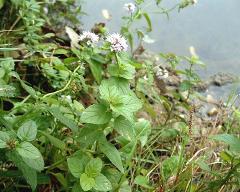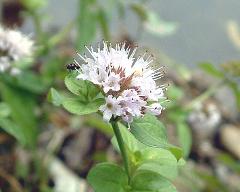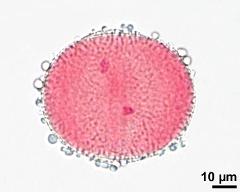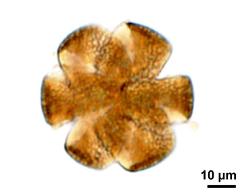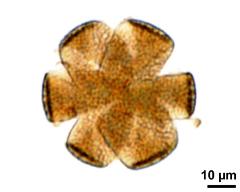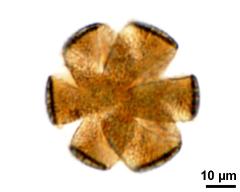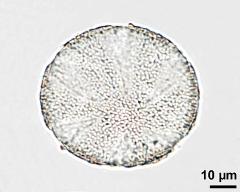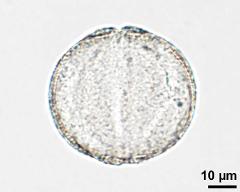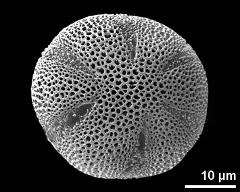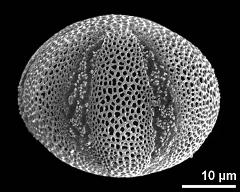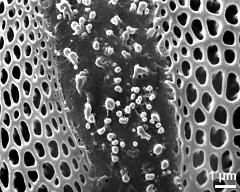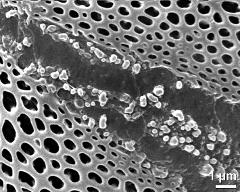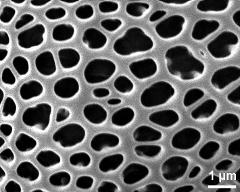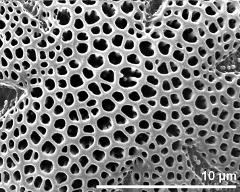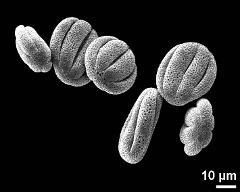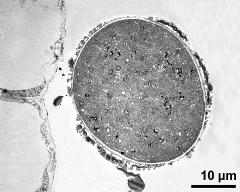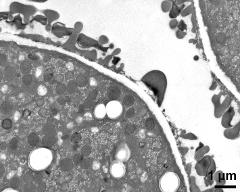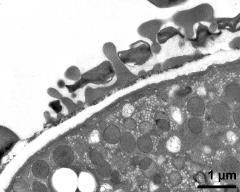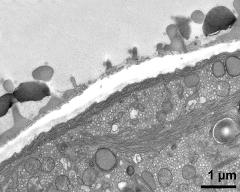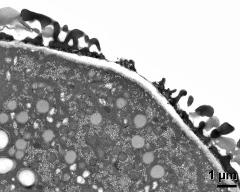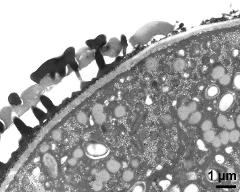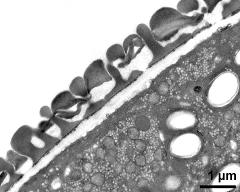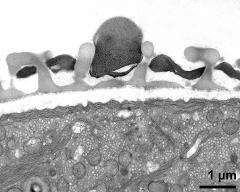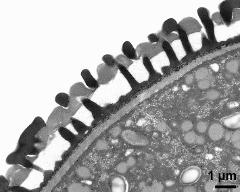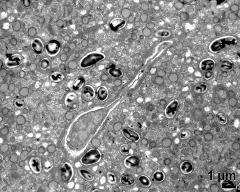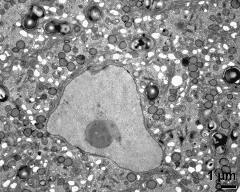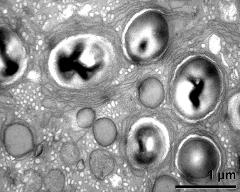Mentha aquatica
Taxonomy: Spermatophyta, Lamiales, Lamiaceae, Mentha
Published: 2005-06-01
Pollen Description
Shape, Size and Aperture
pollen unit: monad, dispersal unit and peculiarities: monad, size (pollen unit): medium-sized (26-50 µm), size of hydrated pollen (LM): -, shortest polar axis in equatorial view (LM): -, longest polar axis in equatorial view (LM): -, shortest diameter in equatorial or polar view (LM): -, longest diameter in equatorial or polar view (LM): -, pollen class: -, polarity: isopolar, P/E-ratio: oblate, shape: -, outline in polar view: elliptic, dominant orientation (LM): -, P/E-ratio (dry pollen): prolate, shape (dry pollen): -, outline in polar view (dry pollen): elliptic, infoldings (dry pollen): aperture(s) sunken, aperture number: 6, aperture type: -, aperture condition: colpate, aperture peculiarities: aperture membrane ornamented
Ornamentation and Structure
LM ornamentation LM: reticulate, nexine: -, sexine: -, SEM ornamentation SEM: reticulate, suprasculpture SEM: -, TEM tectum: semitectate, infratectum: columellate, foot layer: discontinuous, endexine: compact-continuous, intine: monolayered, wall peculiarities: -, supratectal element: -
Miscellaneous
pollen coatings: pollenkitt, reserves in cytoplasm: -, cell number: 3-celled, Ubisch bodies: absent
Author(s) of diagnosis: Ulrich, S.
Pictures
Picture legend
- habitus, photographer: Ulrich, S.
- inflorescence(s), photographer: Ulrich, S.
- sperm cells - dry, rehydrated (water), aceto-carmine, photographer: Ulrich, S.
- upper focus - dry, acetolyzed, unstained, photographer: Ulrich, S.
- optical section - dry, acetolyzed, unstained, photographer: Ulrich, S.
- lower focus - dry, acetolyzed, unstained, photographer: Ulrich, S.
- pollenkitt - dry, rehydrated (water), iodine, photographer: Ulrich, S.
- polar view - dry, rehydrated (water), unstained, photographer: Ulrich, S.
- equatorial view - dry, rehydrated (water), unstained, photographer: Ulrich, S.
- polar view - fresh, rehydrated (water) & critical point dried & sputter coated with gold, photographer: Ulrich, S.
- equatorial view - fresh, rehydrated (water) & critical point dried & sputter coated with gold, photographer: Ulrich, S.
- detail of aperture - fresh, rehydrated (water) & critical point dried & sputter coated with gold, photographer: Ulrich, S.
- detail of aperture - fresh, rehydrated (water) & critical point dried & sputter coated with gold, photographer: Ulrich, S.
- exine surface - fresh, rehydrated (water) & critical point dried & sputter coated with gold, photographer: Ulrich, S.
- polar area - fresh, rehydrated (water) & critical point dried & sputter coated with gold, photographer: Ulrich, S.
- dry pollen grains - dry, sputter coated with gold, photographer: Ulrich, S.
- cross section of pollen grain - fresh, glutaraldehyde & osmium & potassium ferrocyanide, modified Thiéry-test, photographer: Ulrich, S.
- pollen wall; aperture area - fresh, glutaraldehyde & osmium & potassium ferrocyanide, uranyl acetate & lead citrate, photographer: Ulrich, S.
- pollen wall at transition of aperture and interapertural area - fresh, glutaraldehyde & osmium & potassium ferrocyanide, uranyl acetate & lead citrate, photographer: Ulrich, S.
- pollen wall; aperture area - fresh, glutaraldehyde & osmium & potassium ferrocyanide, modified Thiéry-test, photographer: Ulrich, S.
- pollen wall; aperture area - fresh, potassium permanganate, potassium permanganate, photographer: Ulrich, S.
- pollen wall at transition of aperture and interapertural area - fresh, potassium permanganate, potassium permanganate, photographer: Ulrich, S.
- pollen wall; interapertural area - fresh, glutaraldehyde & osmium & potassium ferrocyanide, uranyl acetate & lead citrate, photographer: Ulrich, S.
- pollen wall; interapertural area - fresh, glutaraldehyde & osmium & potassium ferrocyanide, modified Thiéry-test, photographer: Ulrich, S.
- pollen wall; interapertural area - fresh, potassium permanganate, potassium permanganate, photographer: Ulrich, S.
- sperm cell - fresh, glutaraldehyde & osmium & potassium ferrocyanide, modified Thiéry-test, photographer: Ulrich, S.
- vegetative nucleus - fresh, glutaraldehyde & osmium & potassium ferrocyanide, modified Thiéry-test, photographer: Ulrich, S.
- vegetative cytoplasm with organells - fresh, glutaraldehyde & osmium & potassium ferrocyanide, modified Thiéry-test, photographer: Ulrich, S.
Literature
- (1937) European bee plants and their pollen. Bee Kingdom League, Alexandria, Egypt : 164 pp
- (1961) Vegetation and environment in Denmark in the Early Weichselian Glacial (Last Glacial). Dan Geol Unders II: 175 pp, 15 pl
- (1984) A practical pollen guide to the British flora. Quaternary Res Bull Technical Guide I: 1-139
- () Pollenformen und Honigherkunftbestimmung. Bücher des Archivs für Bienenkunde, Berlin 2: 1-122
- (1971) Atlas des pollens des environs d'Istanbul. Istanbul Universitesi, Orman Fakultesi publication : 1-330
- (1972) On the dimorphism of pollen in plants of the family Labiatae from Yakutia. Bot Zh Moscow 57: 1286-1290
- (1986) Claves para la determinación de los polenes de las principales especies melíferas de la Península Ibérica. Orsis 2: 27-54
- (1942) Lehrbuch der Pollenanalyse. Handbücher der praktischen Vorgeschichtsforschung. Verlag Ferdinand Enke, Stuttgart 3: 195 pp
- () Pollen grains in Labiatae. Madhya Bharati India II 14-16: 120-123
- (1986) Subfamilial classification of Labiatae. Systematic Botany 11: 163-185
- (1979) Evolutionary and taxonomic significance in the pollen grains of the order Tubiflorae. Proc IV Int Palynol Conf, Lucknow 1: 268-284
- (1942) New Zealand pollen studies. - I. Key to the pollen grains of families and genera in the native flora. Rec Auckland Inst Mus 2: 280-308
- (1937) O grânulo de polen na classifiçao das plantas. Naturalia, Rev Trimestriel Soc Port Cienc Naturais 1: 199-206
- (1877) Pollen. Hardwicke & Bogue, London : 92 pp, 24 pl
- (1968) Labiatae: taxonomy and susceptibility to Puccinia menthae Pers. New Phytol 67: 739-743
- (1958) The pollen morphology of some Egyptian xerophytes. Bull Fac Sci Cairo Univ 34: 67-73
- (1963) An introduction to a scandinavian pollen flora - II. Almquist & Wiksell, Uppsala : 1-89
- (1961) An introduction to a scandinavian pollen flora. Grana Palynologica 2: 3-92
- (1964) Text book of pollen analysis. Scandinavian University Books, Munksgaard : 1-237
- (1890) Beiträge zur vergleichenden Morphologie der Pollenkörner. Breslau (Thesis) : 1-72
- (1982) Pollen morphology of the West-Himalayan Labiatae. Bangladesh J Bot 11: 107-123
- (1986) Pollen flora of North-West Himalaya. Indian Association of Palynostratigraphers, Lucknow : 181 pp, 29 pl
- (1930) Structure and content of some pollen grains. Iowa Geol Survey Bull 7: 1001-1016
- (1972) Pollen flora of Taiwan. National Taiwan Univ, Botany Dept Press : 297 pp
- (1971) A preliminary revision of Formosan Labiatae (I). Taiwania 16: 157-174
- (1956) Pollen grains of Japan. Hirokawa Publishing Co, Tokyo I-XII: 1-304
- (1989) Morphology of pollen grains of the genus Mentha L. (Lamiaceae). Acta Bot Croat 48: 161-164
- (1952) Atlas zur Bestimmung rezenter und fossiler Pollen und Sporen. Feddes Repert 133: 1-60, 57 pl
- (1978) Pollen dicotyledonearum Florae Partis Europaeae USSR. Lamiaceae - Zygophyllaceae. Nauka, Akad Sci USSR, VL Komarov Inst Bot : 184 pp
- (1987) Acanthaceae, Geraniaceae, Globulariaceae, Lamiaceae, Oxalidaceae, Verbenaceae. In: Valdés B., Díez M.J., Fernández I. (eds) Atlas polínico de Andalucía occidental. Inst de Desarrollo Regional 43, Univ de Sevilla
- (1962) Pollens de plantes mellifères d'Europe - III. Pollen et Spores 4: 247-262
- (1973) Key to the Quaternary pollen and spores of the great lakes region. Royal Ontario Museum, Toronto, Canada : 61 pp
- (1927) Atlas und Bestimmungsschlüssel zur Pollenalytik. Bot Arch 19: 380-499, 50 pl
- (1993) Pollen grains of New Zealand Dicotyledonous Plants. Lincoln NZ: Manaki Whenua Press, New Zealand : 200 pp
- (1834) Über den Bau und die Formen der Pollenkörner. Beiträge zur Anatomie und Physiologie der Gewächse. Erstes Heft. Bern 4: 130 pp, 6 pl
- (1835) Sur la structure et les formes des graines de pollen. Ann Sci Nat, Ser 2 3: 148-180, 220-236, 304-346
- (1992) Importancia relative de especies cuyo polen es utilizado por Apis mellifera en el área de la reserva nacional Los Ruiles, VII región de Chile. Acta Botanica Malacitana 17: 167-174
- (1978) An illustrated guide to pollen analysis. Hodder & Stoughton Ltd, Kent : 133 pp
- (1991) Pollen analysis. Blackwell Scientific Publications. Second Edition : 216 pp
- (1976) Flora und palynomorphs of Alaska. Orion Press, Tokyo : 367 pp
- (1971) On the pollen morphology of Verbenaceae and a few allied taxa with special reference to taxonomy. Univ Calcutta (D Phil Thesis) : 324 pp, 18 pl, 50 figs
- (1965) Pollen grains of Western Himalayan Plants. Asia Monographs India 1: VIII, 1-102
- (1961) Pollen. Talleres graficos DCP, Gerona
- (1976) Pollenmorphology of Indian Labiatae. Tribes Ocimoideae and Satureineae. J Palynology 10: 89-105
- (1968) Pollen morphology of some medicinal and aromatic plants. Journ Osmania Univ Sci, Golden Jubilee Vol : 117-125
- (1992) Pollen et spores d'Europe et d'Afrique du Nord. Laboratoire de Botanique historique et Palynologie, Marseille : 520 pp, 446 pl
- (1956) Die Pollenkörner der Labiaten. Willdenowia 1: 617-641
- (1940) Die Pollenkörner der in Deutschland vorkommenden Labiaten. Verhandl Bot Vereins f Brandenburg 80: 21-36
- (1987) Kartoteka Palinologiczna Roslin Polskich. Opolskie Towarzystwo Przyjaciol Nauk Zeszyty Przyrodnicze 25: 297-306
- (1983) Cytopalynological studies on Indian members of Acanthaceae and Labiatae. J Palynol 19: 243-277
- (1973) Palynomorphs of Japanese plants. Spec Publ Osaka Mus Nat Hist 5: 1-60
- (1987) Monografia polenului florei din Romania. Vol. II. Acad Rep Soc Romania : 144 pp
- (1975) Die Morphologie des Pollens und deren Bedeutung für die Bestäubung der Bienenpflanzen von Rumänien. Bull Tech apicole, Prague 2: 293-316
- (1988) Spores/Pollen morphology. In: Paleopalynology. Unwin Human Ltd, London : 60-116
- (1992) Pollen morphology and taxonomy in North American Labiatae. Can J Bot 70: 975-995
- (1970) Morphological study on the pollen grains of Bambuseae of Taiwan. Bull Taiwan Forest Rest Inst 192: 1-20
- (1960) Pollen grain studies of the Labiatae of Michigan. Webbia 15: 399-415
- (1967) Ein Vorschlag zu einer natürlichen Gliederung der Labiaten auf Grund der Pollenkörner der Samenentwicklung und des reifen Samens. Österr Bot Z 114: 383-483
- (1990) The anatomy, embryology and systematic relationships of Eucommiaceae. Acta Phytotax Sin 28: 430-441
Copyright and Citation
Cite this publication as:
Ulrich S. 2005. Mentha aquatica. In: PalDat - A palynological database. https://www.paldat.org/pub/Mentha_aquatica/109584;jsessionid=3943E6A907F9214F5626B99B2C8E553F; accessed 2024-04-18

